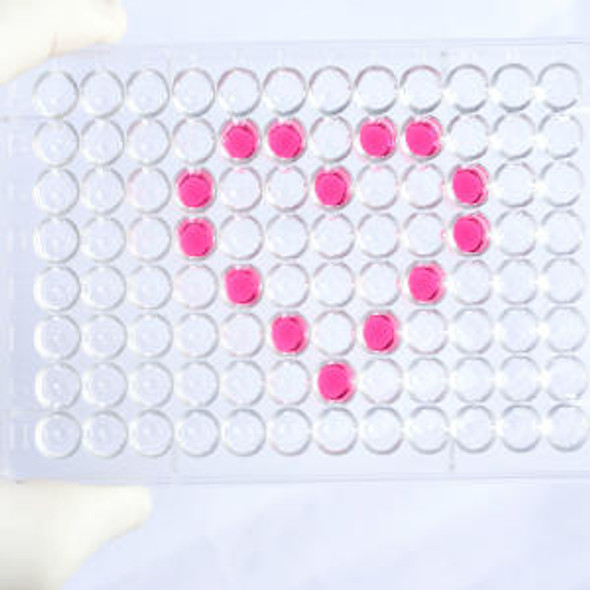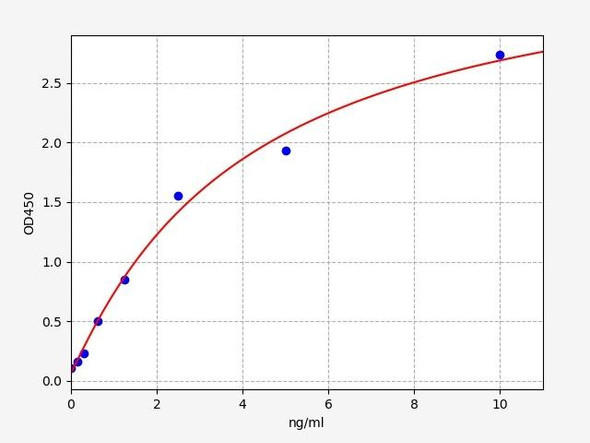Human SIGLEC8 (Sialic Acid Binding Ig Like Lectin 8) ELISA Kit (HUES02374)
- SKU:
- HUES02374
- Product Type:
- ELISA Kit
- Size:
- 96 Assays
- Uniprot:
- Q9NYZ4
- Sensitivity:
- 0.09ng/mL
- Range:
- 0.16-10ng/mL
- ELISA Type:
- Sandwich
- Reactivity:
- Human
- Sample Type:
- Serum, plasma and other biological fluids
- Research Area:
- Cell Biology
Description
Human SIGLEC8 (Sialic Acid Binding Ig Like Lectin 8) ELISA Kit
The Human SIGLEC8 (Sialic acid binding Ig-like lectin 8) ELISA Kit is a reliable tool for the accurate quantification of SIGLEC8 levels in human samples such as serum, plasma, and cell culture supernatants. With high sensitivity and specificity, this kit provides robust and reproducible results, making it suitable for a variety of research applications.SIGLEC8 is a critical protein involved in immune regulation and inflammatory responses, playing a key role in allergic diseases and asthma.
By measuring SIGLEC8 levels, researchers can gain valuable insights into the immune response and potentially identify new therapeutic targets for these conditions.Overall, the Human SIGLEC8 ELISA Kit is an essential tool for researchers studying immune regulation and allergic diseases, providing valuable data for understanding disease mechanisms and developing innovative treatments.
| Assay type: | Sandwich |
| Format: | 96T |
| Assay time: | 4.5h |
| Reactivity: | Human |
| Detection Method: | Colormetric |
| Detection Range: | 0.16-10 ng/mL |
| Sensitivity: | 0.10 ng/mL |
| Sample Volume Required Per Well: | 100µL |
| Sample Type: | Serum, plasma and other biological fluids |
| Specificity: | This kit recognizes Human SIGLEC8 in samples. No significant cross-reactivity or interference between Human SIGLEC8 and analogues was observed. |
This ELISA kit uses Sandwich-ELISA as the method. The micro ELISA plate provided in this kit has been pre-coated with an antibody specific to Human SIGLEC8. Standards or samples are added to the appropriate micro ELISA plate wells and combined with the specific antibody. Then a biotinylated detection antibody specific for Human SIGLEC8 and Avidin-Horseradish Peroxidase (HRP) conjugate are added to each micro plate well successively and incubated. Free components are washed away. The substrate solution is added to each well. Only those wells that contain Human SIGLEC8, biotinylated detection antibody and Avidin-HRP conjugate will appear blue in color. The enzyme-substrate reaction is terminated by adding Stop Solution and the color turns yellow. The optical density (OD) is measured spectrophotometrically at a wavelength of 450 nm ± 2 nm. The OD value is proportional to the concentration of Human SIGLEC8. The concentration of Human SIGLEC8 in samples can be calculated by comparing the OD of the samples to the standard curve.
| UniProt Protein Function: | SIGLEC8: Putative adhesion molecule that mediates sialic-acid dependent binding to cells. Preferentially binds to alpha-2,3- linked sialic acid. Also binds to alpha-2,6-linked sialic acid. The sialic acid recognition site may be masked by cis interactions with sialic acids on the same cell surface. Belongs to the immunoglobulin superfamily. SIGLEC (sialic acid binding Ig-like lectin) family. 3 isoforms of the human protein are produced by alternative splicing. |
| UniProt Protein Details: | Protein type:Cell adhesion; Membrane protein, integral; Receptor, misc. Chromosomal Location of Human Ortholog: 19q13. 41 Molecular Function:protein binding; transmembrane receptor activity Biological Process: signal transduction |
| NCBI Summary: | Sialic acid-binding immunoglobulin (Ig)-like lectins, or SIGLECs (e. g. , CD33 (MIM 159590)), are a family of type 1 transmembrane proteins each having a unique expression pattern, mostly in hemopoietic cells. SIGLEC8 is a member of the CD33-like subgroup of SIGLECs, which are localized to 19q13. 3-q13. 4 and have 2 conserved cytoplasmic tyrosine-based motifs: an immunoreceptor tyrosine-based inhibitory motif, or ITIM (see MIM 604964), and a motif homologous to one identified in signaling lymphocyte activation molecule (SLAM; MIM 603492) that mediates an association with SLAM-associated protein (SAP; MIM 300490) (summarized by Foussias et al. , 2000 [PubMed 11095983]). [supplied by OMIM, May 2010] |
| UniProt Code: | Q9NYZ4 |
| NCBI GenInfo Identifier: | 25009268 |
| NCBI Gene ID: | 27181 |
| NCBI Accession: | Q9NYZ4. 2 |
| UniProt Secondary Accession: | Q9NYZ4,Q7Z728, |
| UniProt Related Accession: | Q9NYZ4 |
| Molecular Weight: | 54kDa |
| NCBI Full Name: | Sialic acid-binding Ig-like lectin 8 |
| NCBI Synonym Full Names: | sialic acid binding Ig like lectin 8 |
| NCBI Official Symbol: | SIGLEC8 |
| NCBI Official Synonym Symbols: | SAF2; SIGLEC-8; SIGLEC8L |
| NCBI Protein Information: | sialic acid-binding Ig-like lectin 8 |
| UniProt Protein Name: | Sialic acid-binding Ig-like lectin 8 |
| UniProt Synonym Protein Names: | Sialoadhesin family member 2; SAF-2 |
| Protein Family: | Sialic acid-binding Ig-like lectin |
| UniProt Gene Name: | SIGLEC8 |
As the OD values of the standard curve may vary according to the conditions of the actual assay performance (e. g. operator, pipetting technique, washing technique or temperature effects), the operator should establish a standard curve for each test. Typical standard curve and data is provided below for reference only.
| Concentration (ng/mL) | O.D | Average | Corrected |
| 10 | 2.42 2.48 | 2.45 | 2.372 |
| 5 | 1.595 1.627 | 1.611 | 1.533 |
| 2.5 | 0.939 0.913 | 0.926 | 0.848 |
| 1.25 | 0.485 0.489 | 0.487 | 0.409 |
| 0.63 | 0.275 0.261 | 0.268 | 0.19 |
| 0.32 | 0.188 0.164 | 0.176 | 0.098 |
| 0.16 | 0.126 0.13 | 0.128 | 0.05 |
| 0 | 0.072 0.084 | 0.078 | -- |
Precision
Intra-assay Precision (Precision within an assay): 3 samples with low, mid range and high level Human SIGLEC8 were tested 20 times on one plate, respectively.
Inter-assay Precision (Precision between assays): 3 samples with low, mid range and high level Human SIGLEC8 were tested on 3 different plates, 20 replicates in each plate.
| Intra-assay Precision | Inter-assay Precision | |||||
| Sample | 1 | 2 | 3 | 1 | 2 | 3 |
| n | 20 | 20 | 20 | 20 | 20 | 20 |
| Mean (ng/mL) | 0.49 | 0.90 | 3.53 | 0.47 | 0.98 | 3.49 |
| Standard deviation | 0.03 | 0.05 | 0.17 | 0.03 | 0.06 | 0.16 |
| C V (%) | 6.12 | 5.56 | 4.82 | 6.38 | 6.12 | 4.58 |
Recovery
The recovery of Human SIGLEC8 spiked at three different levels in samples throughout the range of the assay was evaluated in various matrices.
| Sample Type | Range (%) | Average Recovery (%) |
| Serum (n=5) | 89-100 | 95 |
| EDTA plasma (n=5) | 91-105 | 98 |
| Cell culture media (n=5) | 84-98 | 91 |
Linearity
Samples were spiked with high concentrations of Human SIGLEC8 and diluted with Reference Standard & Sample Diluent to produce samples with values within the range of the assay.
| Serum (n=5) | EDTA plasma (n=5) | Cell culture media (n=5) | ||
| 1:2 | Range (%) | 95-106 | 88-101 | 95-109 |
| Average (%) | 100 | 93 | 100 | |
| 1:4 | Range (%) | 94-105 | 83-95 | 85-101 |
| Average (%) | 100 | 89 | 92 | |
| 1:8 | Range (%) | 88-105 | 80-94 | 87-103 |
| Average (%) | 96 | 86 | 95 | |
| 1:16 | Range (%) | 90-106 | 80-93 | 81-92 |
| Average (%) | 98 | 86 | 87 |
An unopened kit can be stored at 4°C for 1 month. If the kit is not used within 1 month, store the items separately according to the following conditions once the kit is received.
| Item | Specifications | Storage |
| Micro ELISA Plate(Dismountable) | 8 wells ×12 strips | -20°C, 6 months |
| Reference Standard | 2 vials | |
| Concentrated Biotinylated Detection Ab (100×) | 1 vial, 120 µL | |
| Concentrated HRP Conjugate (100×) | 1 vial, 120 µL | -20°C(shading light), 6 months |
| Reference Standard & Sample Diluent | 1 vial, 20 mL | 4°C, 6 months |
| Biotinylated Detection Ab Diluent | 1 vial, 14 mL | |
| HRP Conjugate Diluent | 1 vial, 14 mL | |
| Concentrated Wash Buffer (25×) | 1 vial, 30 mL | |
| Substrate Reagent | 1 vial, 10 mL | 4°C(shading light) |
| Stop Solution | 1 vial, 10 mL | 4°C |
| Plate Sealer | 5 pieces | |
| Product Description | 1 copy | |
| Certificate of Analysis | 1 copy |
- Set standard, test sample and control (zero) wells on the pre-coated plate and record theirpositions. It is recommended to measure each standard and sample in duplicate. Note: addall solutions to the bottom of the plate wells while avoiding contact with the well walls. Ensuresolutions do not foam when adding to the wells.
- Aliquot 100 µL of standard solutions into the standard wells.
- Add 100 µL of Sample / Standard dilution buffer into the control (zero) well.
- Add 100 µL of properly diluted sample (serum, plasma, tissue homogenates and otherbiological fluids) into test sample wells.
- Cover the plate with the sealer provided in the kit and incubate for 90 min at 37 °C.
- Aspirate the liquid from each well, do not wash. Immediately add 100 µL of BiotinylatedDetection Ab working solution to each well. Cover the plate with a plate seal and gently mix. Incubate for 1 hour at 37 °C.
- Aspirate or decant the solution from the plate and add 350 µL of wash buffer to each welland incubate for 1-2 minutes at room temperature. Aspirate the solution from each well andclap the plate on absorbent filter paper to dry. Repeat this process 3 times. Note: a microplatewasher can be used in this step and other wash steps.
- Add 100 µL of HRP Conjugate working solution to each well. Cover with a plate seal andincubate for 30 min at 37 °C.
- Aspirate or decant the solution from each well. Repeat the wash process for five times asconducted in step 7.
- Add 90 µL of Substrate Reagent to each well. Cover with a new plate seal and incubate forapproximately 15 min at 37 °C. Protect the plate from light. Note: the reaction time can beshortened or extended according to the actual color change, but not by more than 30min.
- Add 50 µL of Stop Solution to each well. Note: Adding the stop solution should be done inthe same order as the substrate solution.
- Determine the optical density (OD value) of each well immediately with a microplate readerset at 450 nm.






